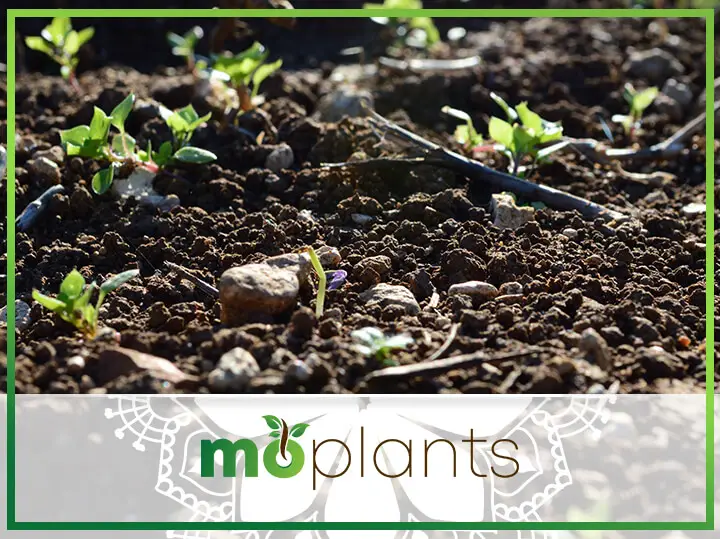Have you noticed a large number of rocks on your soil? Maybe there’s an outcropping of several boulders, small rocks, or compact gravel, and you don’t know what to do.
If you’re wondering how to remove rocks from soil the best way possible, this article can help.
Rock removal can either be done manually or by machine.
To find out the best method and machine for whatever you need during the rock removal process, read our guide below. You’ll pick up on tips and ways to repurpose unwanted rocks as well!
Why Should Rocks Be Removed From Your Yard?
When you’re planting something in your garden or yard, rocks can get in the way. They do nothing for your plants’ growth, occupy soil, and deprives them of proper growing space.
Proper water and nutrient penetration also don’t occur with rocks on your soil. As a result, plants become weaker and may die off. There’s a high likelihood that what all rocks do on your property is make the soil stiff!
Most rocks are unsightly as well. If the aesthetics of your yard or garden are important to you, it’s understandable to want to remove them from the soil.
Overall, water, nutrients, and space for your plants are essential. Rocks may be impeding your plants’ ability to get access to them.
Read our list below for the best methods and machines that will help you in removing rocks from soil.
The Best Methods and Machines to Remove the Rocks From Soil
In this section, we’ll discuss how best to remove rocks from soil. We’ll mention some tools and machinery that you may need for your rock removal project. Make sure to take note of them!
First, Think About Location and Division
Locate all the rocks you need to remove in your yard or garden. Then, divide the locations you found by size.
The Best Automated Methods and Machinery
Bring Rocks to the Surface
You can loosen the soil in several ways. The following machines are best for small-sized rocks. For medium-sized rocks, one can simply pick them up.
Rototiller
You can loosen large areas of soil using a rototiller. A rototiller is a gardening tool and machine that looks similar to a lawnmower. It uses gas and electricity to power the blades and churn and break soil.
A rototiller can reach specific depths, varying in inches.
Besides loosening up the topsoil, a rototiller also kills weeds. This versatile tool comes in different models and performance power.
You have the option to use either the front-mounted or rear-mounted model to make your gardens rock-free!
Cultivator
A cultivator is easier to use! However, it’s not as heavy-duty as a rototiller. Instead, it’s more lightweight and compact. A cultivator’s tines in front of its wheels and contains blades similar to star wheels.
If the soil isn’t that hard to break, or you’re dealing with a smaller garden, this is a cost-effective tool for you. You can always avail of a more high-performance cultivator to get the job done.
It improves and prepares soil well. It can also remove weeds from the area.
Tractors
A tractor is one of the most powerful machines you can use to remove rocks. It’s especially efficient for larger rocks as well.
It comes with a variety of attachments, like plows, buckets, and rakes.
You don’t have to invest in such a powerful machine – you can just rent a tractor near your location. While it’s much less labor-intensive, it’s also costly.
If you already have a tractor and plow, simply attach the latter to the tractor. Then, use it to loosen up the topsoil. Scoop up the ground in sections.
Skid steer loaders or Bobcats
A skid steer loader or a bobcat is another powerful machine that can help in removing rocks.
They are used to landscape lots. They are also used to aid in construction and excavation. You can remove everything from smaller rocks to large boulders.
Just like a tractor, it can come with a variety of attachments.
You can choose from small-frame, medium-frame, and large-frame bobcats. You can also choose to hire or rent this machine for your landscape project.
Use a Soil Sifter, Screen, or Net
If you use a tractor or bobcats, you can buy attachments like rock buckets to sift the soil. However, you can also choose to buy a sifting screen.
You can buy or make a sifting screen, separator, or net out of expanded metal or chain link.
Think of a chain-link fence and build or buy a screen from that idea. This screen will help filter out the soil from the smaller rocks you want to remove.
Medium rocks and big boulders wouldn’t need to go through this process. It’s easier to store them elsewhere.
Other Reminders
After scooping and sifting, rake stones into a pile. You can choose to store either soil or rocks in a bucket or wheelbarrow. Keep these out of the way until you’ve finished tilling your soil.
Once you have sifted everything, you can spread the soil back onto your garden, yard, lawn, or field.
Can You Use Manual Methods and Hand Tools to Remove the Rocks?
Of course! While automated machinery is ideal, a lot of gardeners, landscapers, and homeowners may prefer to save some money.
To remove rocks from soil yourself, you can always choose to do manual ways to remove rocks. Here, you can use hand tools.
You may notice that the following sections are largely similar to the process above – just with fewer machines.
Bring Rocks to the Surface
Before starting the rock removal process, it’s important to loosen the soil to get to the rocks underneath.
Shovel
You can loosen the soil up with a pointed shovel. Dig a bit deeper – remember that some rocks can be hiding below the surface. Then, shove up what you can.
Landscape or Gardening Rake
Use this tool in loosening the topsoil up! Rake soil and stones the same way you would rake leaves.
Pick Out The Stones
For small rocks, use a shovel and a sifter or screen to separate them properly.
Handpick Rocks with Gardening Gloves
The simplest way to remove any rock is to just pick them up.
For medium-sized and large-sized rocks, you can handpick them for efficiency. Use gardening gloves to protect your hands from rubble, dirt, and any sharp edges that rocks may have.
Dig Out Rocks Using A Bar
A steel bar is an effective tool in digging out rocks underneath the surface. Use your shovel to see how deep the rock goes underneath the topsoil.
Then, use the steel bar near the edge of the rock to dig it out.
This is especially effective in removing large rocks! However, don’t strain yourself by transporting these large boulders or rocks by hand, as well.
It’s much easier if you choose to put them in a wheelbarrow or other similar tools so you can safely deposit them elsewhere.
Enjoy the Fruits of Your Hard Work
Removing rocks isn’t an easy job! Whether you used manual or automated ways to tackle this task, now is the time to enjoy the sight of your clear, fresh, topsoil.
Now, you can plant your dream vegetables, build wood frame garden beds, and plan landscape projects.
What About Gravel?
If you or previous homeowners used a geotextile cloth underneath the gravel, then simply lift it to remove it.
However, you can also remove gravel using machinery and tools just like the rocks and boulders we’ve discussed above.
The geotextile cloth or landscape fabric might have suffered weathering as well! This weathering would have caused it to become compact gravel.
Know What Type of Gravel You’re Dealing With
Make the process easier and faster by researching the type of gravel you’re dealing with in your home. It’s a good idea to check the amount of gravel as well!
Screened Gravel and Pea Gravel
Screened gravel is one centimeter wide, while pea gravel is around two centimeters. Between the two, screened gravel can be compact and much harder to remove.
Use a Rake
After removing gravel by hand, the best way is to use this tool. Rake the gravel, put it into a wheelbarrow, and transport it out of your yard.
Use A Bobcat
The next best way to remove gravel is to use a bobcat. It will scoop up the gravel, haul it to another site, and then prep the ground for other functions.
It can accomplish the work you need to do for the entirety of the area in hours. In comparison, the rake and shovel method can take days.
While gravel looks small, it can get quite heavy to remove.
Consider the time and labor to put in if you’re wondering whether to do gravel work by hand or with a machine.
Is Removing Rocks From Soil Expensive?
The cost depends on what method and machinery you choose for the rock removal process.
If you choose to go with manual methods and hand tools, chances are the only expense you’ll be making is your time.
It’s a lot of labor to remove rocks. It might exhaust you and whoever you’re working with, especially if you’re dealing with medium and large rocks.
However, investing in machinery to remove rocks from the soil is also a good option. It’s efficient and convenient. It won’t take up as much energy or time.
Keep in mind that using machinery can get costly. Budget well and see if your chosen way to remove rocks from your garden or yard is enough to manage whatever the price is.
Tips to Remember When Removing Rocks From Soil
Remove Rocks Before Planting Anything
If you only remove rocks after you’ve already planted several shrubs, bushes, or flowers, then that may be a lot of hard work and money down the drain.
Remember, rocks kill off plants just by taking up space! They block the water and nutrients your plants need.

Look Beyond the Surface
When loosening soil up, dig 10 to 12 inches into the soil. There is a high likelihood that rocks are hiding underneath the topsoil.
Just because one can’t see the rocks easily on the soil doesn’t mean they don’t exist. Make sure you remove all these rocks effectively.
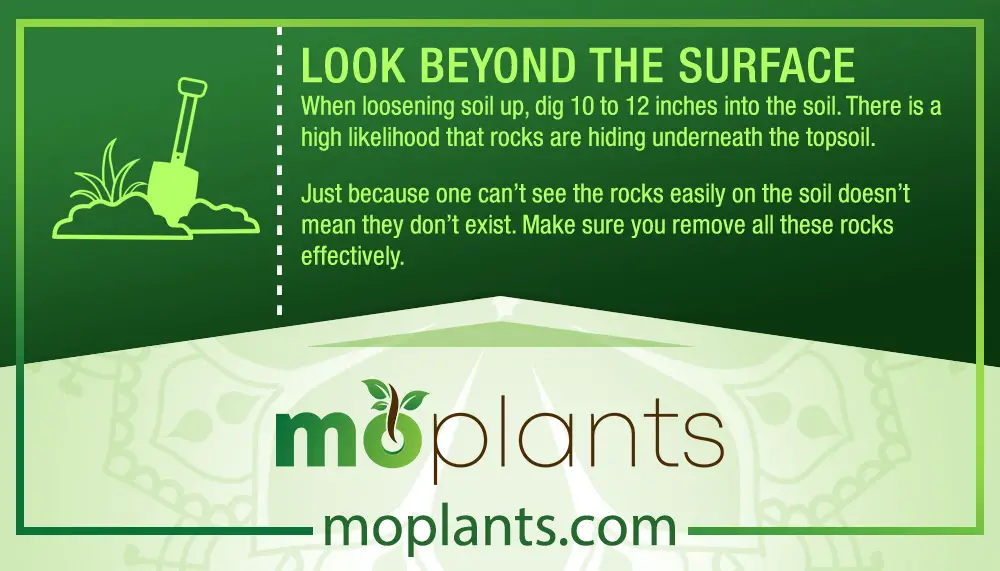
Check the Landscape Fabric
Did you buy this house from another family? Maybe you’ve inherited it. Whatever the case, you should check if previous homeowners put down geotextile cloth or landscape fabric under the gravel.
This kind of fabric prevents the growth of weeds. You can lift this to remove it or use machinery and tools. While it does kill weeds in your yard, it also suffocates the soil and beneficial worms and insects.
The landscape fabric can also already be showing signs of deterioration. If the fabric already has holes in it, then it’s not preventing the growth of weeds at all.
A wheelbarrow and shovel are both effective in getting the landscape fabric out.
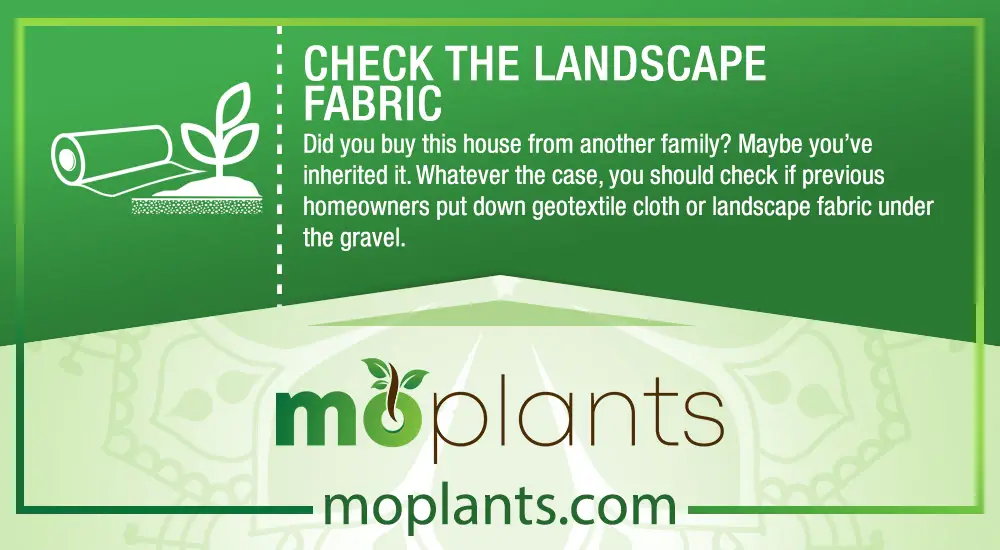
Don’t Use a Lawnmower
It’s not advisable to use a lawnmower for this kind of job.
Using a lawnmower to remove rocks from the soil will only result in a broken lawnmower and wasted time. If the lawnmower doesn’t suffer destruction, other people might be injured.
Lawnmowers can send rocks into the air at high speeds. These rocks can hit random strangers, your family, or small animals. Be very careful when you decide to take on this task.
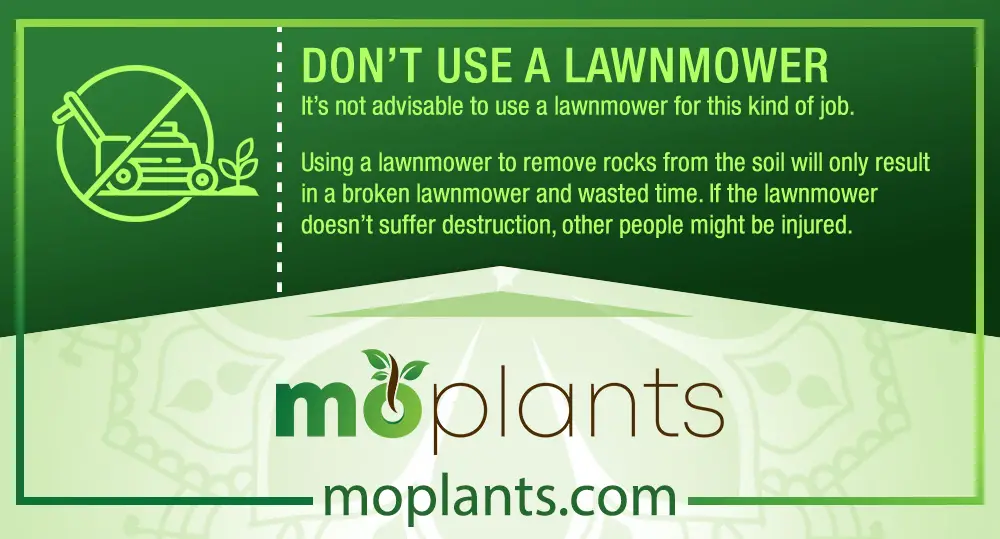
Infographic
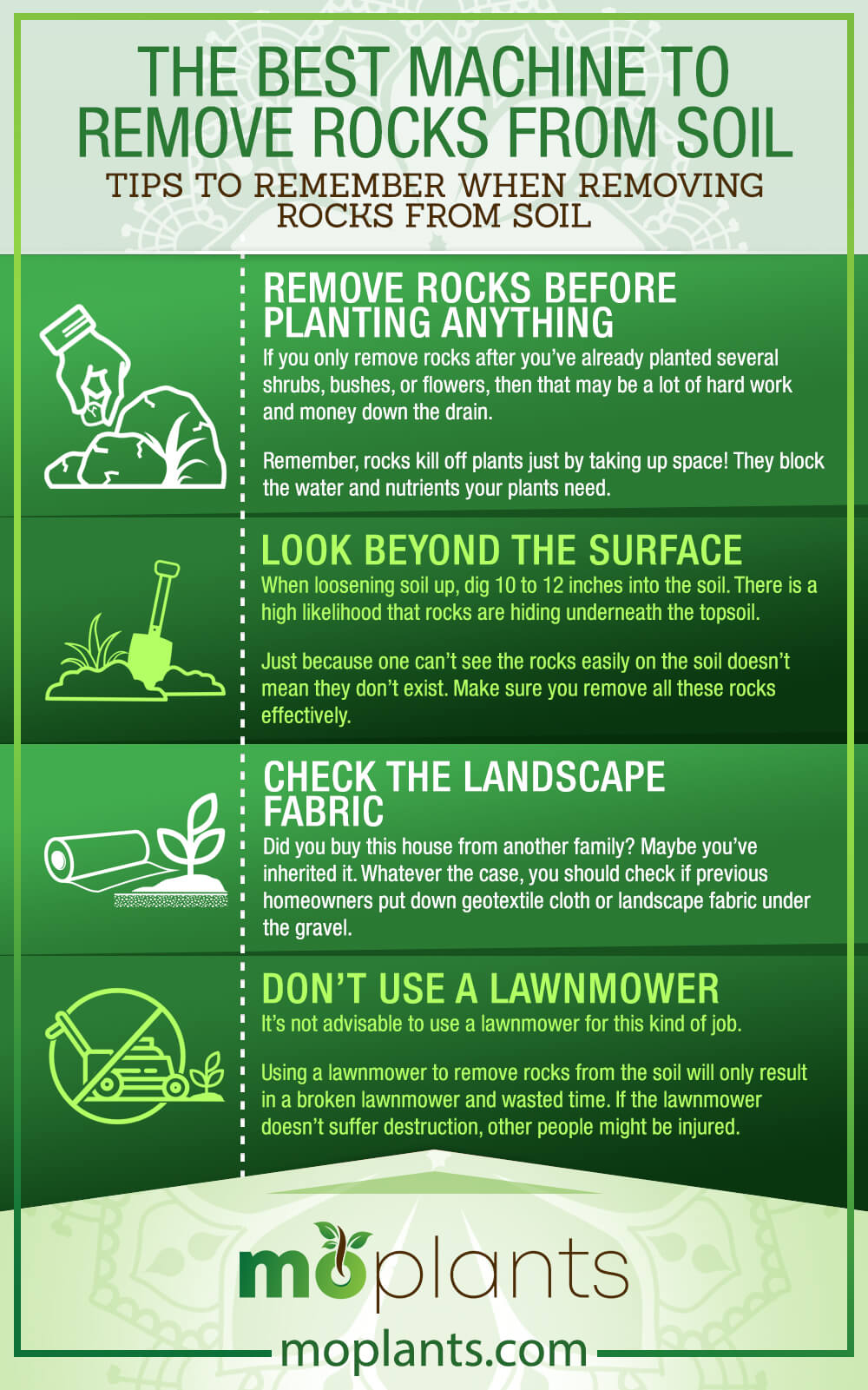
What If You Only Want to Remove Rocks in a Small Area?
The rock removal process may be too expensive or time-consuming. Maybe you want to keep a rocky soil or want to clear out a small area for specific plants.
Don’t worry. You can choose to do the rock removal process in a small area and still have plants thriving in the rocky soil!
Some Plant Options for Rocky Soil
The following list is a selection of plants you can choose to put in rocky soil.
Herbs
Some herbs prefer a rock environment compared to organic, loamy soil. Sage, oregano, and catmint are all great options if you want a large area to be filled with herbs quickly.

Succulents
Rocky soil is low-nutrient soil. While some plants may reject it, succulents will thrive in it! They can be frost-sensitive, so check the succulents’ temperature needs before you put in gardening work.

Juniper Trees
This plant won’t give you any sort of problem – it’s low maintenance and adapts to a wide variety of soils. They won’t mind being put in rocky soil at all! They do require good drainage and consistent moisture.
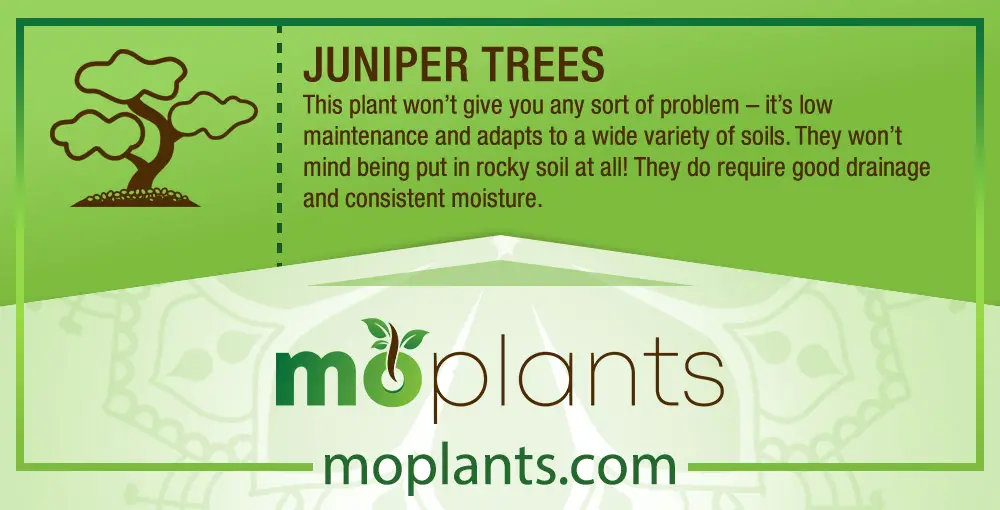
Ornamental grass plants
Before you get rid of all the rocks in your garden, you might want to reserve an area for ornamental grass plants!
Rocky soil conditions are appropriate for these plants and will provide your garden with bright foliage.
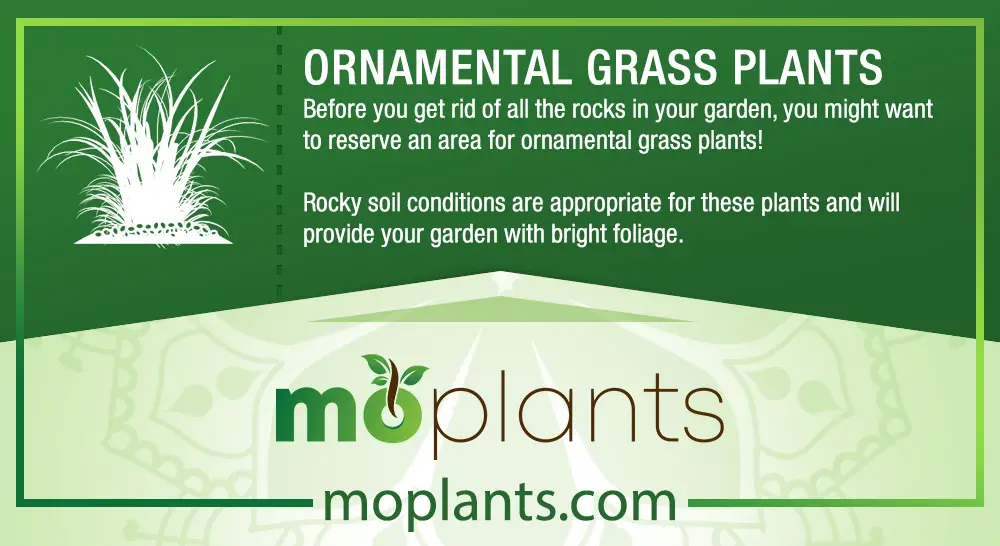
Infographic
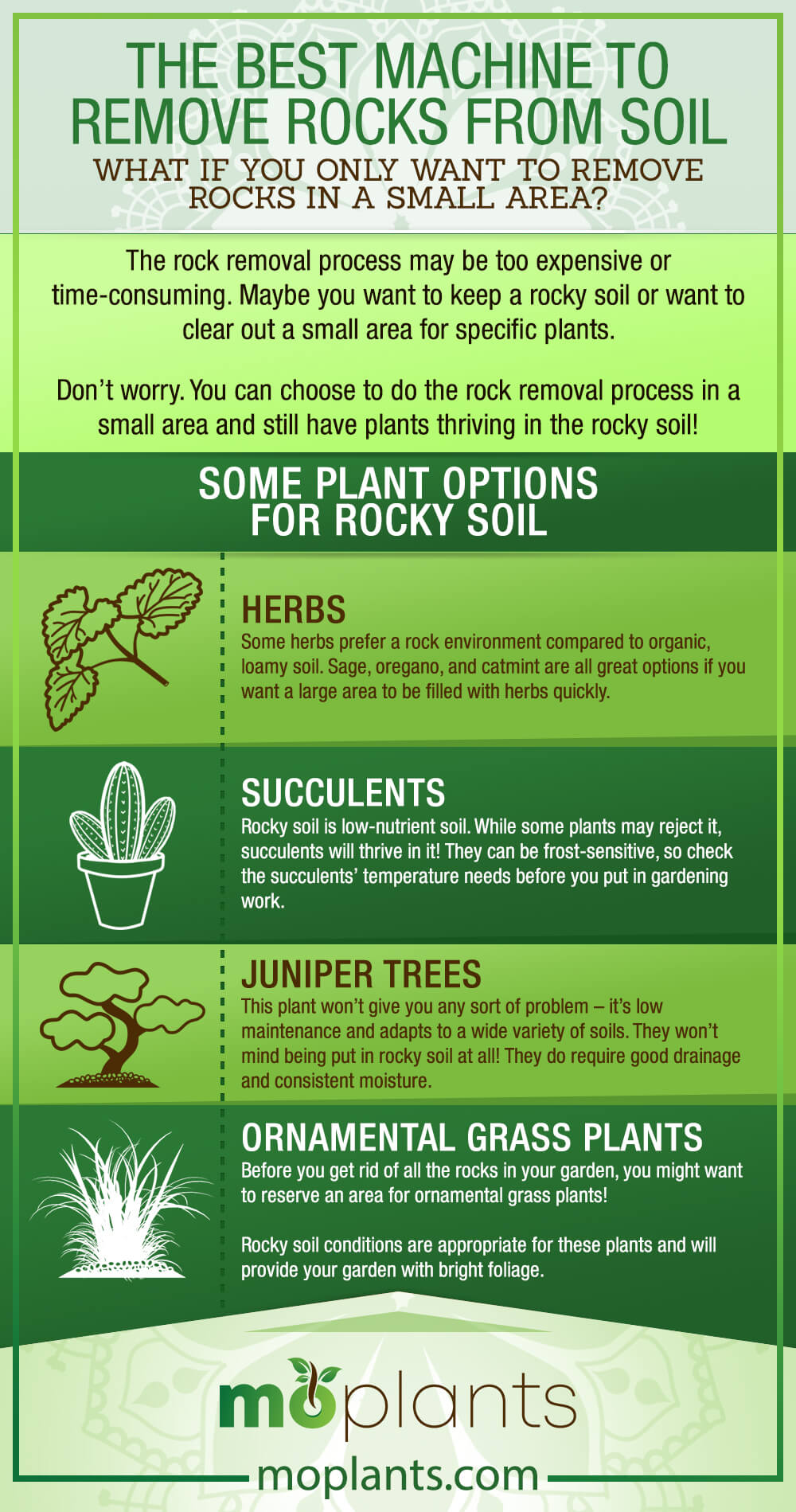
What to Do With Rocks and Stones
Congratulations, you’ve gotten rid of the rocks in your yard!
Now that the work is over, you might find yourself facing enormous piles of rocks and stones. While some of these rocks you can dispose of, you may be wondering if there are other uses for them.
One thing you can do is to repurpose rocks and stones for a creative landscaping project in your garden.
Make a Fire Pit
A fire pit can be a fun addition to your backyard. Work on a fire pit using the stones, sand, gravel, shovel, and rake! Some tips: choose a spot away from overhanging structures or trees.
Design a Path or Walkway
Transfer some of the gravel you originally wanted to get rid of into another area where you’d like a decorative path or walkway. You can even make stepping stones using the larger rocks.
Emphasize Your Plants
Surround plants, flowers, and shrubs with a semi-circle of rocks and stones.
Once you remove rocks from soil, choose ones that go together in terms of size and color. Arranging your rocks and stones for decoration is the best way to make sure your favorite plants stand out!
Create a Retaining Wall
Don’t know what to do with that boulder? Use the rocks and boulders to create a brand-new retaining wall.
Clean unwanted rocks after the rock removal process and see if they can fit together for your garden’s retaining wall.
Poor drainage, soil, and access typically happen in sloping areas. A retaining wall is the best way to fix this. It will hold back soil and create a level planting area. In effect, it will solve the problem many of your plants could be facing, and change the look of your yard.
Conclusion
The rock removal process can take up a lot of your time and energy. Our needs as people are different, and it doesn’t change here.
You may want to remove rocks from the entire yard, or only a small area.
You might want to remove rocks by hand to save money, or you might want to have it done as quickly as possible using machines. You may want to repurpose your rocks or not at all.
We hope that this article provided you with enough information to customize our tips and tricks to your needs. We wish you luck with your project! If you’ve got relevant experiences, opinions, or comments to share, feel free to do so with this post.

